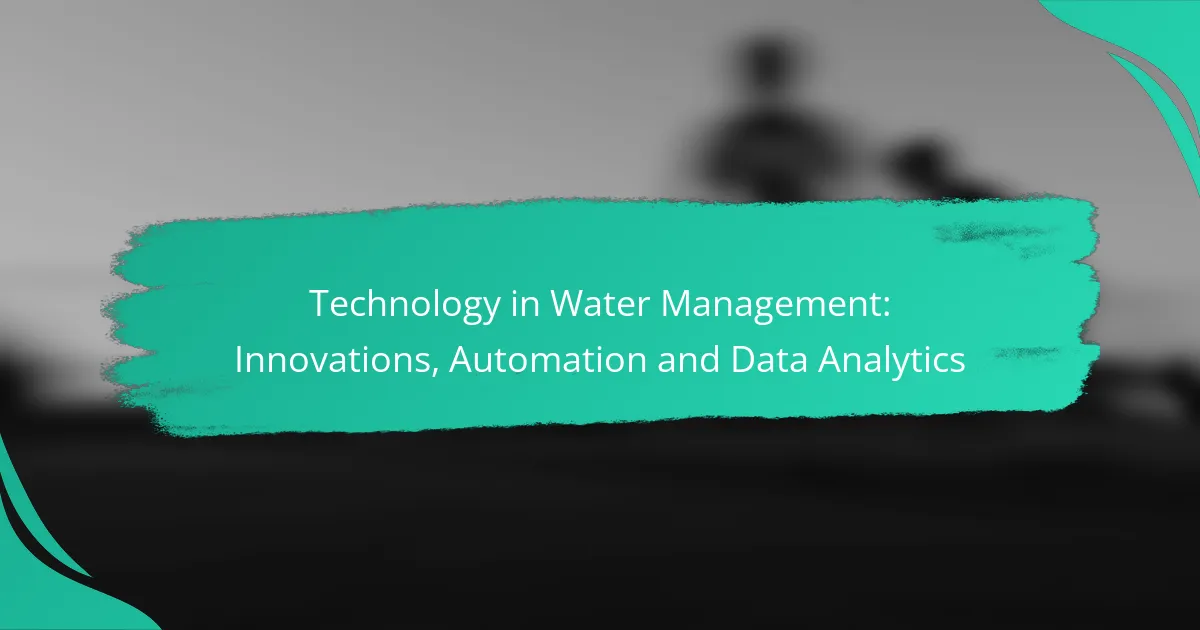Technology is revolutionizing water management by improving efficiency, minimizing waste, and facilitating better decision-making through automation and data analytics. These innovations allow for optimal resource allocation and promote sustainable practices, ultimately enhancing the effectiveness of water distribution and treatment systems.
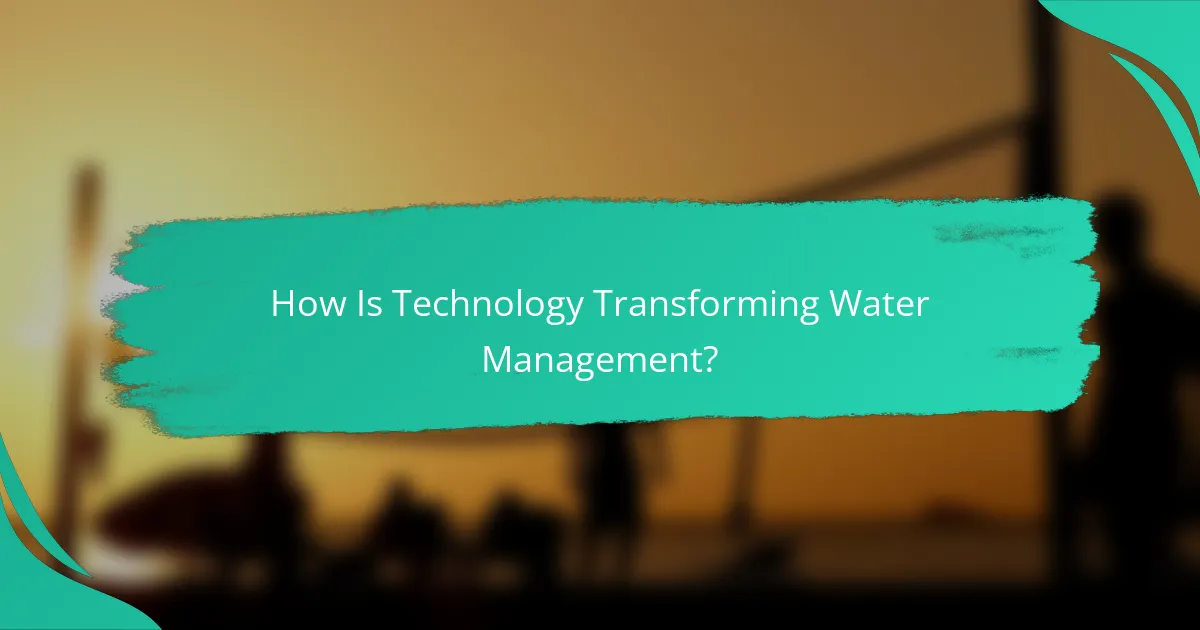
How Is Technology Transforming Water Management?
Technology is significantly transforming water management by enhancing efficiency, reducing waste, and improving decision-making through automation and data analytics. Innovations in this field are enabling better resource allocation and ensuring sustainable practices in water usage.
Smart irrigation systems
Smart irrigation systems utilize sensors and weather data to optimize water usage in agriculture and landscaping. These systems adjust watering schedules based on real-time conditions, which can lead to water savings of up to 50% compared to traditional methods.
Farmers can implement drip irrigation combined with smart controllers to ensure that crops receive the right amount of water at the right time. This not only conserves water but also promotes healthier plant growth and higher yields.
Remote monitoring technologies
Remote monitoring technologies allow for continuous oversight of water resources and infrastructure from a distance. Using IoT devices, managers can track water levels, flow rates, and system performance in real-time, which helps in identifying issues before they escalate.
For instance, municipalities can monitor reservoir levels and distribution systems to optimize water supply and detect anomalies. This proactive approach reduces the risk of shortages and improves overall service reliability.
Water quality sensors
Water quality sensors are essential for ensuring safe drinking water and maintaining ecosystem health. These sensors can detect contaminants, pH levels, and other critical parameters, providing immediate feedback on water quality.
Regular monitoring with these sensors helps water treatment facilities comply with health regulations and respond swiftly to contamination events. For example, continuous monitoring can alert operators to harmful levels of nitrates or bacteria, allowing for quick remediation actions.
Automated leak detection
Automated leak detection systems use acoustic sensors and data analytics to identify leaks in pipelines and distribution networks. By analyzing sound patterns, these systems can pinpoint leaks with high accuracy, often before they become visible.
Implementing such systems can reduce water loss significantly, saving municipalities and businesses money on water bills and repair costs. Regular maintenance and updates to these systems ensure they remain effective in detecting new leaks.
Data-driven decision making
Data-driven decision making in water management involves analyzing large datasets to inform strategies and policies. By leveraging historical data and predictive analytics, managers can forecast demand, optimize resource allocation, and enhance operational efficiency.
For effective data-driven strategies, organizations should invest in data collection tools and analytics software. This approach allows for informed decisions that can lead to improved sustainability and cost savings in water management practices.
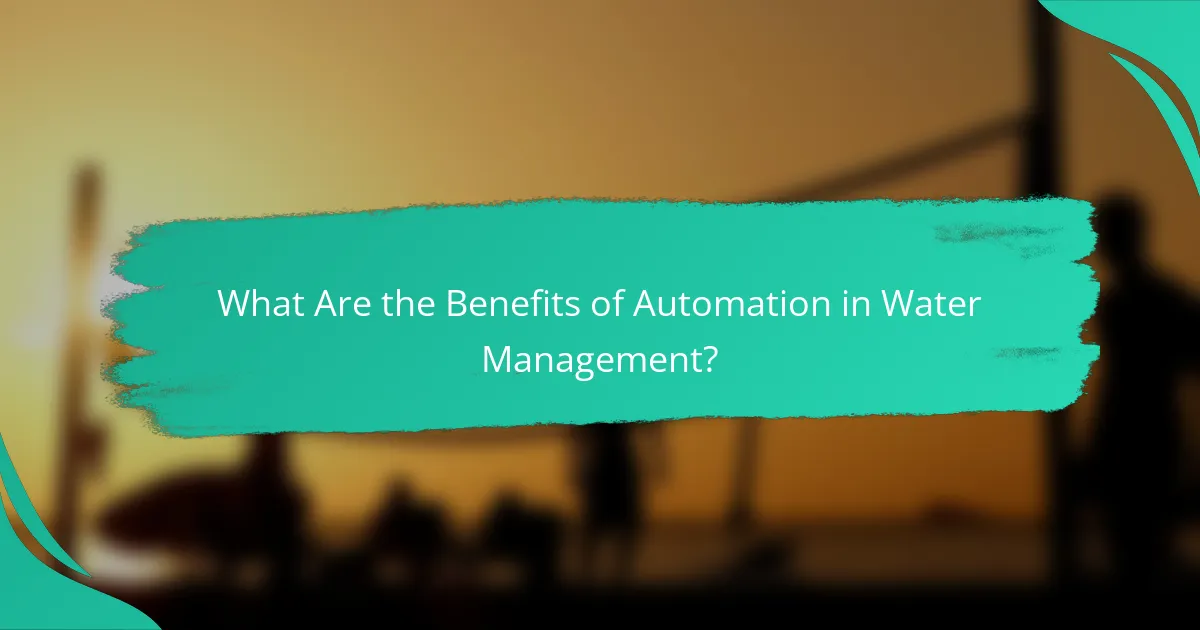
What Are the Benefits of Automation in Water Management?
Automation in water management offers significant advantages, including enhanced operational efficiency, reduced costs, and better allocation of resources. By integrating technology, organizations can streamline processes and improve decision-making in water distribution and treatment.
Increased efficiency
Automation increases efficiency by minimizing manual tasks and optimizing workflows. For instance, automated monitoring systems can continuously track water quality and flow rates, allowing for real-time adjustments without human intervention.
Additionally, automated irrigation systems can adjust water usage based on weather forecasts and soil moisture levels, ensuring that resources are used effectively and reducing waste.
Cost reduction
Implementing automation can lead to significant cost reductions in water management. By reducing labor costs through automation, organizations can allocate resources more effectively, often resulting in savings of up to 30% in operational expenses.
Moreover, automated leak detection systems can identify issues early, preventing costly repairs and reducing water loss, which is particularly important in regions where water scarcity is a concern.
Improved resource allocation
Automation enhances resource allocation by providing data-driven insights into water usage patterns. This allows managers to make informed decisions about where to direct resources, ensuring that areas with the highest demand receive adequate supply.
For example, advanced analytics can help identify peak usage times and adjust supply accordingly, which is crucial for maintaining service levels in urban areas. By prioritizing resource allocation based on real-time data, organizations can improve sustainability and operational resilience.
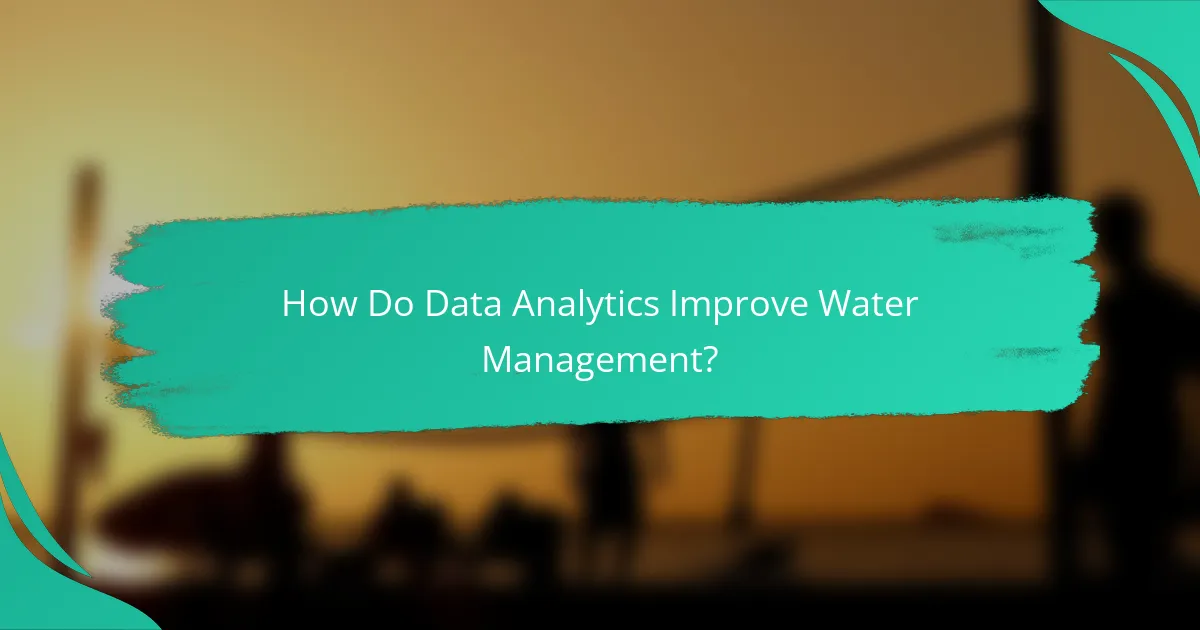
How Do Data Analytics Improve Water Management?
Data analytics enhance water management by providing insights that lead to more efficient resource allocation, reduced costs, and improved service delivery. By analyzing data from various sources, utilities can make informed decisions that optimize operations and address issues proactively.
Predictive maintenance
Predictive maintenance uses data analytics to anticipate equipment failures before they occur. By monitoring the condition of pumps, valves, and other infrastructure, utilities can schedule maintenance during non-peak hours, minimizing service disruptions and reducing repair costs.
For example, sensors can track vibrations and temperature changes in machinery, alerting operators when maintenance is needed. This approach can extend the lifespan of equipment and improve overall system reliability.
Usage pattern analysis
Usage pattern analysis involves examining water consumption data to identify trends and anomalies. By understanding how and when water is used, utilities can tailor their services to meet demand more effectively.
For instance, analyzing data over time can reveal peak usage periods, allowing for better resource management during high-demand seasons. Utilities can also identify potential leaks or inefficiencies, leading to significant water savings and cost reductions.
Demand forecasting
Demand forecasting predicts future water needs based on historical data, population growth, and seasonal variations. Accurate forecasts enable utilities to plan for infrastructure upgrades and ensure adequate supply during peak times.
Utilities can use statistical models and machine learning techniques to refine their forecasts, adjusting for factors like weather patterns and local events. This proactive approach helps prevent shortages and supports sustainable water management practices.

What Technologies Are Leading in Water Management Innovations?
Leading technologies in water management innovations include IoT devices, AI and machine learning, and cloud computing solutions. These technologies enhance efficiency, improve data analysis, and facilitate better decision-making in water resource management.
IoT devices
IoT devices play a crucial role in modern water management by enabling real-time monitoring of water quality and usage. Sensors can track parameters such as pH levels, turbidity, and flow rates, providing valuable data for operators.
For effective implementation, consider deploying devices that are compatible with existing infrastructure and can withstand environmental conditions. Regular maintenance and calibration are essential to ensure accuracy and reliability.
AI and machine learning
AI and machine learning algorithms analyze vast amounts of data collected from various sources, helping to predict water demand and optimize resource allocation. These technologies can identify patterns and anomalies, leading to proactive maintenance and reduced waste.
When integrating AI solutions, ensure that the data used for training models is diverse and representative. This helps improve the accuracy of predictions and minimizes the risk of biased outcomes.
Cloud computing solutions
Cloud computing solutions provide scalable storage and processing power for water management data, facilitating collaboration among stakeholders. They enable easy access to real-time data and analytics from anywhere, improving responsiveness to issues.
Choosing a cloud provider with robust security measures is critical to protect sensitive information. Additionally, consider solutions that comply with local regulations regarding data privacy and environmental reporting.
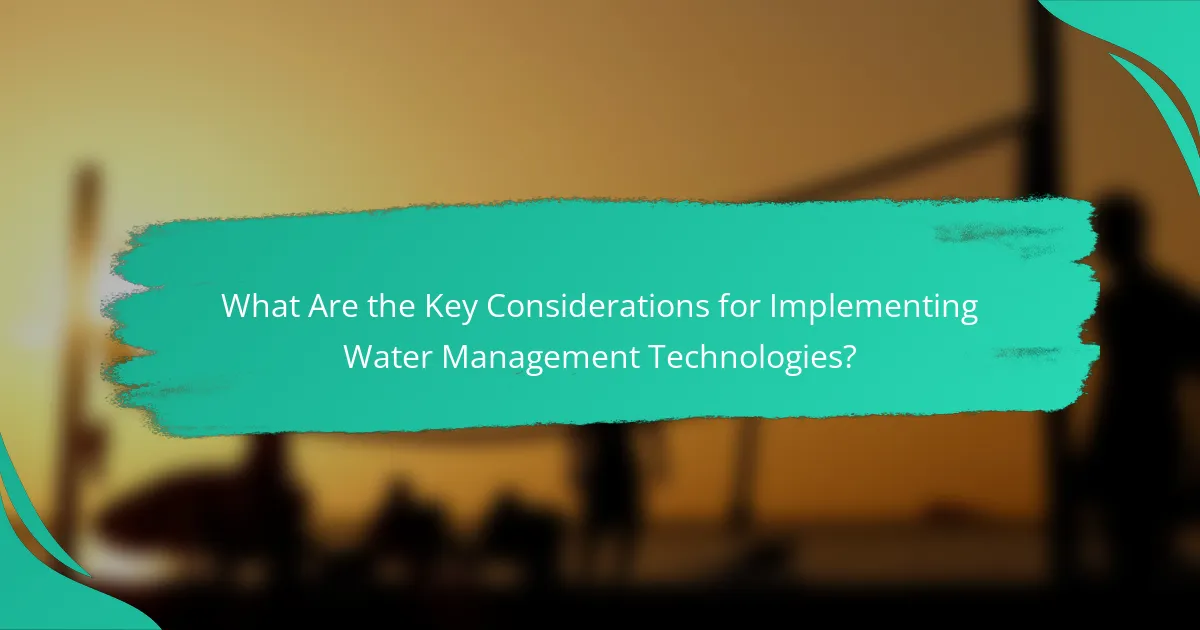
What Are the Key Considerations for Implementing Water Management Technologies?
When implementing water management technologies, key considerations include cost-effectiveness, regulatory compliance, and the potential return on investment (ROI). These factors can significantly influence the success and sustainability of water management solutions.
Cost vs. ROI analysis
Conducting a cost versus ROI analysis is essential for determining the financial viability of water management technologies. This analysis should include initial investment costs, ongoing operational expenses, and anticipated savings or revenue increases from improved efficiency.
For example, a smart irrigation system may require an upfront investment of several thousand dollars but can reduce water usage by 20-30%, leading to significant savings on utility bills over time. Establishing a clear timeline for ROI, typically within 3-5 years, helps stakeholders make informed decisions.
Regulatory compliance
Ensuring regulatory compliance is crucial when implementing water management technologies. This includes adhering to local, state, and federal regulations regarding water usage, quality, and conservation practices. Non-compliance can result in fines and project delays.
For instance, in the United States, the Clean Water Act sets standards for water quality that must be met by any new technology. Familiarizing yourself with relevant regulations and obtaining necessary permits can streamline the implementation process and mitigate risks associated with non-compliance.
